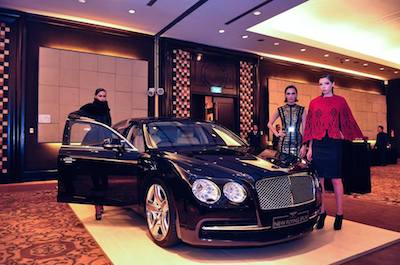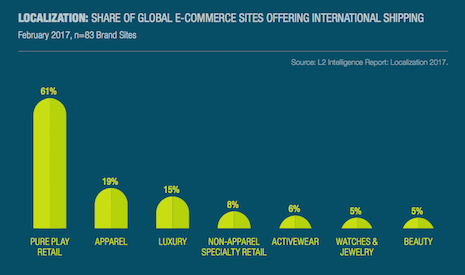The 3.5 million high-net-worth individuals located in the Asia Pacific region makes the market increasingly important for the luxury sector, as the affluent group's appetite for high-end continues to grow.
Countries of the Association of Southeast Asian Nations are becoming an increasingly important part of consumerism in the luxury market. Countries that make up the association such as Brunei, Cambodia, Indonesia, Laos, Malaysia, Myanmar, the Philippines, Singapore, Thailand, and Vietnam are expected to become the fourth largest economy by 2020.
“The ASEAN nations are part of a high-growth region where we are active in terms of member growth and hosting globally focused events – and the affluent consumer is definitely part of that growth,” said Paul Boomsma, president of Luxury Portfolio International and chief operating officer at Leading Real Estate Companies of the World. “There are 3.5 million high-net-worth individuals in the Asia Pacific region worth an estimated USD17.7 trillion.
“Singapore already has a huge concentration of wealthy individuals, while the number of millionaires in Vietnam is expected to rise significantly in the coming years,” he said. “We are seeing that the growing middle and upper classes in the region have substantial spending power and are an emerging luxury market.”
Market importance
ASEA’s population number is double the size of the United States and larger than Europe.

Bentley holds Indonesia fashion event
More than 3.5 million high net worth individuals reside in Singapore, while the Philippines expects its middle class to grow. Middle class in the country is likely to increase by 41 percent from now until the year 2030.
The fourth largest middle class region in the world is Indonesia with consumer buying expect to propel the country into a major marketplace in the future.
Marketers looking to conquer this region need to focus on the values and culture specific to these areas or risk falling behind. It is not enough to just assume, marketers need to immerse themselves in the local traditions and really become a part of the local culture.
Additional insight
Chinese travelers represent the largest bloc of luxury consumers in the world, suggesting that luxury brands need to pay more attention to their international customers.
This data comes from Kinetic, which analyzed the shopping habits and trends for the luxury market in an attempt to discern the largest demographics in international luxury shopping. The data also showed that luxury shoppers at international airports are ripe for targeting through geofencing technology (see more).

Graph courtesy of L2
In reflection of this growth, Italy’s Salvatore Ferragamo S.p.A. recently took full control of its distribution in Southeast Asia.
The parent company of Salvatore Ferragamo Group has acquired the remaining 20 percent of shares in its SEAK joint venture with Trinity Ltd.’s subsidiaries, giving it 100 percent of the capital from its distribution companies in the region. A number of brands have sought to own their operations in international markets, allowing them to have a stronger handle on their retail efforts (see more).
“Luxury is both universal and specific,” Mr. Boomsma said. “For anyone trying to understand the ASEAN region it's very important to become aware of the culture, traditions and values in order to be best positioned to market to what matters most to these consumers.
“There's no substitute for visiting and making connections at the local level,” he said.
{"ct":"Fy\/VkCGqZqGH098uko+4R005mAXGJqSJkbzQXV0W7vsYVJk2Kw5XwKHnF\/EODNfSYMLQTRMSztZkSEL58AKkGi6ZxRd44c1wD2z8pMN4SqnzaqiHJBIfdwofjr1N0stoRYRPcTM5Yuvu4NOtPHPQMngPx+OUjLMsqxj+9NGny\/BpuXeFS8bMujZJWC13NlWzNraYPlxmn852Cub8CmUeuHqx2Scmqwu2z8Whlla0VTioHvLpE1zSM+DDiauKjIF7QQ\/SnWad1MuN0LQ+1pjAxhunYuZBsqq0mMTmNHrZy0getGexlaUcqZ6OMNajQqbQKRDJ+iMEMO10CiRkiOVX0M2mJGJON54n9oCWOyqeACcU\/T5T8h6HKmOqo5IhHX9VRUqlnI18ne457hEpokeRQHXLdtRCPCnuU7+zv5I++gp8Jf2u+\/xds6\/szLG0ru+bRD9bQOP9T+28eUGPy+2YUkVdzpqHm33bSxbsTZCwcU8ohBR6Rqz9MdkerDi1vnK6386fVwUXrBihfeB+xlQ\/2B3+Yr8IVzvygSyjlXjRVB1n7GRj5xbo3LiOQWy7ys2R1GYYK5OWuLQcejNRI9n3itn7VVGMTrSZshLmMdHsv5tzoFrZKigP\/nSzmYGPgt+u3uDccMTbdWsBGAd+EG87kawr3Btg7REeSQgsq\/FiRcORpw1leW5ivDiNzicL2gcEcyEHouFzz2Tp2Q\/wD5OaM68hV4oh48PPQtgPFWerl3gLXAkdDfZw+OWtYbxIyKGsVRbfM+n24f5f0YTO5S6gZyOqblO97eCn1WqFIBEZ4r0\/7FGy\/4hhWlngV8cHEHWD7JVVW61+QvOXebL4uLfCMyuZmmLdVAkPfjaBvVJIP+hxn3XUYJHOJpfOKsegdApx5igEUPQ8zomVdgFTDKiPrPIX14d7a8tgDL7MdaXyaSyKJUV+n4WMLM4e4bQuu4oY5RnUqnLszrU3htm2fK992ctgTnlj3yyaCLbMcR4\/foGuZwIhJGrsaGiNHidW8wbNDVjkKhcKGpakxZpnz7xBm+tGtVoCfgl\/sKJ6suWHUXrIZKl2TEoT7HH5e9IkYK06YuzMHzz7J7wcPgW6hLhWvrHjIMpsa3QPJcotkO0wLTrMM1khggLEDg6q1brg6XI+b\/Ktg7Q8Zm+yZL4Qh\/aReCT5WtjGTB0b2p36UmUPeayzQZJPe1b7cieoXwosfa7Qd0sMRMjskWC5MDREF81lmESv9zZwgKDvZQJtHrNI8YydZ7sjRpnw22StTuwKdyagCIO6BT1wy+acXAYI3SLSSrv4Mg2zd5hQHveofL2sif0aP3bxF0QLQ4aj1EY5cqAle+vJUsSzlLA7kc+FeuecVnLcEHFbEOEN4O9hC8L+rhgg0BV2Kd+wZe5BWiE77c2XcNQcHeItqZXdoAcVg7D3V4DyxogpfGpnBY5HAifsywocdxRgmRTaL3c6pfMcYLqvJtDmdhF2zC2Yg1bBFG52xIvfXekhlx\/LdK+iKEplUtX5A48UYb18KYscEYZeq7WLfDeyVw1R0TDy++aeBzRXK+\/HFuVrCTpm6bGWQZWO1fwOubNnpFVjKH\/Zcg9Ijm9xOx2v3v5cjs4mSRdE6v3pmqJjdycpaKxjXKDSWUajfj3g\/m1GyYcmGMi50SrLnl\/lCoQxEhsrKIFhVInboYyFAXKtpnVNl3d4F2Hmi7CJem4wmeSSt5930oJ\/YrnZhHT8pNtgj26o\/pr45LDZ8mo\/JPS1zxVvg1wTli\/31GOis1W77jEQxQBXqSu64bcBNrtxCFrJb4cuALyqwZtyjy7VgTyRJloi1scRkysoblzhwN+Zz4tD6dp8xpEMgM+IBudOkTsp879MoD89fSQoj5Tz44f5BJ4HIIhQY8TEMrBYM01wT2Dy7EOQUyqgEQWX3SlGn+Z6P3BBVLJd6YrkSj+tq6KtWStl1g7\/BtA+kz83oSRLNaLEEfAoHkQ2FXtaxD\/sGXUEGLCE8XqM2GFjery6SDt5K8PBChB7L8S2TdU8iYCY0+l4uqbVGfxjNVqM9UHq3\/+M2VuLYAbk8y6WKq64Cn++aHxqA9gNEnkWUEfsvHX5Ld4+yK+E2vy4CD06d2Rec8HL9ojstUUKKwGNVNLCsk15W0doN\/MFKaMhwXn1Mj3B8tLn9SZuErJe936TEZgWYW+vApbLvTGEcI1JMA4Q5dfOMuu2l6coYblst5SALTDv4WGHTHzrOPVs4R8dk0\/1j9gB2SRt754MuGmPzYez7fNyVAGsT+rnLJQo6FU3xRKLCSx+X2NdlNg\/tHHfwqznYIzppfBjKzKu953BRSQxi20res1JN++IPEkOebb2jkpXZgsWlwrvy2Q7wewgnUQ8xF2W7PQmE2wNrC\/DjO+pu9+ToalNR\/sYYRFGhjKPVOzVabDV0Z5MBbdm7lz0i16wwyUeG2EBGCOAo2PdFdVJdaQcHtCxx561wmG\/tSNzX1\/2vr7c6F0AhPYDTQ9QaN1v3i2zLtIGfI1eEQiXZSynJQeZKUOTgzZIt5XzI0qQ+AXs3yHfcyTPHEYUby6rxjVe6VuwgGj9oAMLq9np5wpFrDy9RkBiwcN9JH1O2JK58LFwEZTDjn77LayAH4o7PSj6lVxNfzW6BBiFQAClqbx0WsjbZUb4i0Ow7xWeHh6dkoZNFawxKkEnTEA4d8DunHLqua21qn\/v9My1jW+mqxQ1VcXbsh\/OS7R6M4sFUGsbVTI0X2t36kSwsE9gUqzoh7vqS3S1F42WTGFPgP1WJAItep1eoRSRdZe4bwQNuSi3OuBIDEOTQmcskDoM0ynBWTMpsh+lW9yeAb7HZmVL8PB6scWYQTg5\/KBRaJPnqcWCg\/RKxj5lBeGv8EZqttH5uKLeufpJBDf\/VoOHWvzQV2V3aS3CKLNPYzpB8hQ1J8d1wyookuxZDDTtIbhEFujtO\/P+7aT6Dh4pIVoEIsoPsLLv\/DXBU37Kh0ylsBXjKWEHxkCc+6wcuOVG2eEUtRRFYZowWvxkvupZnjGOdvtNkxPUeYi0Z+G9qCNjD+CG0Lj8X51hv7kL19wo3+AoSwUlJOSf9DaxLp5jAOX70Qm2f\/A\/cv3tZJkP4aPL8jMOC3yw2B\/5d66P3lyPArnmHCeJFpkEa53JZ\/7jmUe1OMlBudpW34lSzBjo5uhtqrs3vDFeFReh+njV5Cw7+UH7mTUFZGqeXkIbhNT9grtrpJR5cPEpNlqnA2yc6BGA4QEmZonlSLuMVipCk7o+mJScFPcIJTvr3ZY7Lq\/bAdd5mUaTb9PZM0Rjf1vKo+K\/iCUNhPdLk9CxYGZiWaytwng\/4WroeH0savri9u6LrKGCtDFtSzQuBEeO5pFpn4RlJA5HmlPUs2AxLj\/DE1qwafmBFz6WOdva4tULzm1bJwI8g2E7RgAgoy5FLRdvUtk6B9gsCOhtYP+zaHBgUTUlIFYpM6iAapDjaN7LOPTdZpp1BjxwdAA\/4aecfKbyF3Zf3flEfAFh+QeH8Lf2PWyJW1P1v1FuICp+U6wTfGo+jjEgWT16fbOXCidZUQv8g\/OYFESQAlTlLIrA7ltRhyl4vIQJRyxaJb63YWKxQ++o0YcRUt951rwqNdPLjGCpWIooU9LlaLXSsiBfDeiTg5aG99YX5AOdmWTCvSuS25hYlAS8kHoOa+Nrl3Lppw\/LjzW\/\/sLsopimm5H+Y+cqqNKcjK3PvOS02pv+wxHlXLJpTWiMq6qyHcLjIaKqG8fgW5lIe8GeGv\/xzAUYVQeOhSZgTLYy7w8GEKkXNUROSxWJN2xLptLSs5aQWSjNJgliOZqDGeaepTO1sjd5v7gZOXQ4vkkBOErWdbtMAJ37hAHGe00bkdGAqv3ZmUVdh9w029UVno96CKzkHqsj16vyOLgyMriaoF26z4peGQyeWmKRHTDqCJI764LLvw77ei0ORGr5J5hOFqG9hl0NNwdnX9f1UFrDOKd\/jWeZ9LjW4e4IxfJMLGhUkdUgfuMz+6w9sQDPulqYC1p4MZ6rqqLu\/Qhpu5v39GPNN4m\/buo9jr+fY7q3fykLkhuLohhk\/sseEEqqWRNdsVmqWeoAOJqK+lIhEazBiNL0auUAOft5lWN7CMexce9DngO\/Ndl6Cr\/HzLHIVaZSA6DTqbUMIUy3AjgG+fCVqtcsHI5cVWRJWxx+xjwmosBcOhHIak8C02\/rJmCLz++I4QgSkUsiYbtPRwsKnHzYfk\/Oia7Ncy4jOIieQNlDZMbH3C7zVPR8lAWauwuHEpgAYnJXXr87HgUeNhu4X5JK4fksFj8yssA4JDzdtzu+Vf5I3td\/lnHqAv8AGSZfpKasGd7IaPOYte7qO5Gg+RadVLBDKvP8WiSQ8gV6xVrKR\/N2810CP7N8AdEYnNEZzbUNNO1ZQN+x+TWXNoRgDVvuobAeap69xXDCkZzImuyMEkdUvbWBTIiOzy7DJYr2kefQHOR1QOuiCCtDf+gzQKohU39hMa3l4JG6sz12u8TSx4r0L3xQNwQ8NlpVuS+LZHdY382QzqjcaS3Vo9dzz\/VJc+ga+2fgONp5mnS89u4XwapHUfleXGcqqs2A0hV8EwuavFUpt73yjxpVSsayW0gtIMhGVsKT2wyO+Fbh19Kcha02k87zrBi3F6FuLLifTSnScT9foDt1PGspVJ\/LitEOaS00JFAqbqknQMil\/SY4zhRBHubvQBx7h\/9040UJhpKoRs5W0Tc7t4Bx5VTy+TVVa0nDoxxne206OrW+kqKurIw9t89u6tR6rMv8qKrgcROrwMY5NtnAbaROFFgsHyEF13rOvdryBsi4vPLuHuEOT0LmpkonCk8E+tAQoTAzINPMv2\/GezYAdfsZeR2Ki6qRICkgnVXW1A7qYZbsNtWj85Mc7Dcz8FW+peRZwAIhu6EcAmCgRmmmneLf++Odzd0tuRa\/7knjKhn6vboCU2JWRoy72l9Pe0nt6EvQ2xWaOYg8CmN+tCqFegx1YAvNx80jqMoCtkIsNbaPaZNc5VGlz80+X47EhDRpy7JNj8ONKzqGYLELxH4vJjM9h1FMhgJiSSbI1lM0uWRoQ3k3jhXlIz+alSyhI7DABji5DvlGpNmukPgEjzr18RrwqRzkFbDf2UgUIOrkoOCdMGnCBmbrI08hqfp3No3JKxgP\/Mo3dMVnniEW7\/Xesi11qiBbpGKp7JqQ7eYWgau64fAtBu9FR0IxM9MJf5VLP8Lfz7Yr\/Zmz5ONOLsZylL1bUiJZ39ljxrju2TkcrAoNGtSQFJ3e1ExsefgkywtLXDvTFYz3BPdZFOCwm2okSVZ5yvWpkz1vhRz\/tF\/j2gna2UfTL15GPhZVuyrjiPFGHqAJ+tQ306soAr0Z\/hgbEBV27Cw3g\/bNtXW2k+B7z+riGRMK6quXpsPFQPdrHJn7\/hg3QcJV02bTGqoksN16vzfmQ60FpI6tWWcFalJFQja7EUFrlUReZez59gWugilE+LF3PN5lpgkhBCO2uy+eapCmXYx2+FA6ns6bN0wCqmiFRQYpKg5XCGBPiONGxpOpS0xVzMgysqPHYnuJEtTUz69WJjffX1DQm7lhqexahdU\/7DiIenZ5lDm1LWaDVq12p3mHTxtuuHqWmXtmAYzyx7qezcQjP+2R+lyN\/KPMjut7kzA51jcVoX91ufuWs3ppviARpZ+iXXliIf0DQ2tPiuiWLFOqBR59vHZ6iMI7mdflG\/jma5u2O7Y7bvAhTUn5LQCxts9e0BJtpp0QufamJK28kL0EOHWgjovcXRB7IxMwQEbEFUWO6e6\/H6YBQvdGdJIupxE+Y5vZ1cJUa8mwkjAHVbzmzxUrEIxIEbbBFaVwaBxjwBiawG96RJAkU8xDJiz1qqcJiysb9kzc5Fbu+GdyVBwV9mhB3fCiDcuZQk\/ioepd7QZj6i9gdw6QzOomb5rVKXtx7hZCgvTlnuMu3lICDltnRRuYITVasOhRBJ4\/L3PERKhJJTyzFfzTI84nxSi8hjkpIfI+XFq\/ph\/SyFFxtN3QNyV4Pnk6fxMfSpH5uQEstbbO0g3IXF1+2LJeA53oqMmrtCGP9pGyFinpSq8sJvYkIuEZKQgxjSN2ST9WoazKVh8VZ67xM\/NLndT80m5Uu7oUUNWqJFtD9x+tr3yvFJog8kmZYSeBUFaJPSbJ5iMEqGhiQQik8J9J3Y+MAsC95ecf1mBqAwUAlnLITXstmVrqOCT0v2jtyW4S3r4vji5QVSYzFYi6X9on1e0h6R36+iissFLxiCbIDk+dg3s02yOShrfGEYRSqhfKaBZNvwnz5GyDGX8iFNUvxDovDhGHS4q3JRx4Fj1FYKGo4pgFyaJ1OMo3K5w8\/OC+BhMvzj1Q0qFEwMBaj0GNbA44mkSsjXvT8Xh8JjG\/OcystHGdMA3b9w27R46VhlnzcT6hsYnRBxepKYlAokKblA==","iv":"ced5891bc6858cbd1bdb96b30965dfa0","s":"a141240109a6c021"}

 The Duxton Club, Singapore. A Luxury Collection property
The Duxton Club, Singapore. A Luxury Collection property